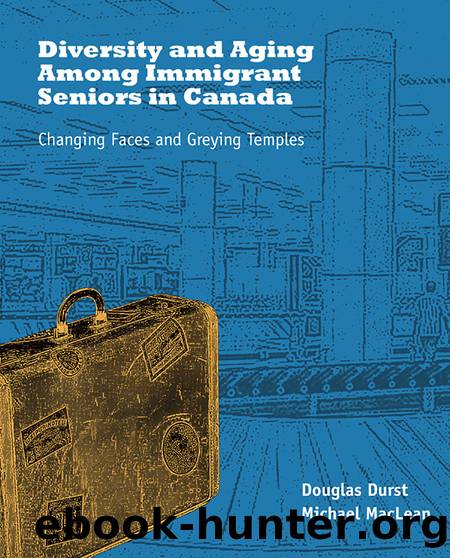Diversity and Aging Among Immigrant Seniors in Canada by Douglas Durst Michael MacLean

Author:Douglas Durst, Michael MacLean [Douglas Durst, Michael MacLean]
Language: eng
Format: epub
ISBN: 9781550598155
Barnesnoble:
Publisher: Brush Education
Published: 2019-05-21T00:00:00+00:00
Literature Review
Healthy Aging as an Emerging Focus
With population aging comes more interest in research and policy to address seniorsâ health. âHealthy agingâ is an emerging focus in government policies at the provincial (Alberta Community Development, 2000; British Columbia Ministry of Health, 2005) and federal levels (Healthy Aging and Wellness Working Group, 2006). Healthy aging can be understood as part of the concept of âgood health,â which refers to ânot merely an absence of illnesses or infirmity, but a state of complete physical, mental and social well-beingâ (World Health Organization, 1946). One definition of healthy aging focuses on illness and impairment, wherein freedom from both becomes the hallmark of healthy aging (Bassett, Bourbonnais & McDowell, 2007; Ostbye et al., 2006; Reed et al., 1998). However, having illnesses and functional disability may not imply being unwell (Strawbridge, Wallhagen & Cohen, 2002). Many older adults consider themselves to be aging well despite having chronic conditions or disabilities (Strawbridge, Wallhagen & Cohen, 2002). Being able to adapt or manage physically and attitudinally to functional declines and maintaining functional autonomy are some aspects of healthy aging (Jang, Mortimer, Haley & Graves, 2004; Michael, Coditz, Coakley & Kawachi, 1999; Ostbye et al., 2006; Ryff, 1989). Healthy aging also means active participation, remaining socially engaged, maintaining positive interactions with others, taking part in activities, and having close personal relationships and social ties (Jang et al., 2004; Ryff, 1989; Knight & Ricciardelli, 2003). The spiritual aspect of healthy aging includes anticipating the future, having a sense of purpose, personal growth, an appreciation of life, and being able to have inner self-reflection (Fisher & Specht, 1999; Knight & Ricciardelli, 2003; Reed et al., 1998; Ryff, 1989). These different but related definitions have shown that âhealthy agingâ is a multi-dimensional concept, and it should be understood from a multiple perspective that includes consideration of the different socio-cultural contexts of the older adults.
Based on a recent review of healthy aging (Peel, Bartlett & McClure, 2004), it is clear that most studies adopted the âsocial determinants of healthâ and âpopulation healthâ perspectives. Two major orientations can be identified, one taking an epidemiological approach to address specific health problems, focusing on factors predicting disease and disability. The prevalence of specific lifestyles or health behaviors of individuals has come under intense scrutiny (Laroche, 2000), with the assumption that if some seniors stay healthy, others should be also able to if certain preceding conditions are present. Research findings show that these conditions include a low fat diet, regular physical activity, volunteering, moderate alcohol consumption, and being a nonsmoker (Almeida, Norman, Hankey, Jamrozik & Flicker, 2006; Byles, Young, Furuya & Parkinson, 2006; Herzog, Ofstedal & Wheeler, 2002; Michael Colditz, Coakley & Kawachi, 1999; Ostbye et al., 2006; Reed et al., 1998; Steptoe, Wright, Kunz-Ebrecht & Iliffe, 2006; Thompson, Sierpina & Sierpina, 2001). Another approach these studies take aligns with the holistic perspective, and seeks to understand the role of external influences on healthy aging, including the role of public policy (Infeld & Whitelaw, 2002), the social
Download
This site does not store any files on its server. We only index and link to content provided by other sites. Please contact the content providers to delete copyright contents if any and email us, we'll remove relevant links or contents immediately.
Spare by Prince Harry The Duke of Sussex(5071)
Machine Learning at Scale with H2O by Gregory Keys | David Whiting(4167)
Fairy Tale by Stephen King(3216)
Will by Will Smith(2788)
Hooked: A Dark, Contemporary Romance (Never After Series) by Emily McIntire(2495)
The Bullet Journal Method by Ryder Carroll(2479)
Rationality by Steven Pinker(2290)
Can't Hurt Me: Master Your Mind and Defy the Odds - Clean Edition by David Goggins(2224)
It Starts With Us (It Ends with Us #2) by Colleen Hoover(2193)
Friends, Lovers, and the Big Terrible Thing by Matthew Perry(2116)
The Becoming by Nora Roberts(2085)
Love on the Brain by Ali Hazelwood(1962)
The Strength In Our Scars by Bianca Sparacino(1776)
HBR's 10 Must Reads 2022 by Harvard Business Review(1776)
A Short History of War by Jeremy Black(1758)
Leviathan Falls (The Expanse Book 9) by James S. A. Corey(1646)
515945210 by Unknown(1597)
A Game of Thrones (The Illustrated Edition) by George R. R. Martin(1585)
Bewilderment by Richard Powers(1535)
